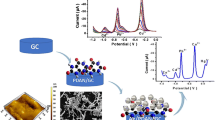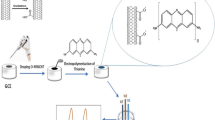Abstract
A method is described for the simultaneous voltammetric determination of the heavy metal ions cadmium(II), lead(II), mercury(II), zinc(II), and copper(II) using a glassy carbon electrode (GCE) modified with magnetite (Fe3O4) nanoparticles and fluorinated multiwalled carbon nanotubes (Fe3O4/F-MWCNTs). The Fe3O4/F-MWCNT composite was synthesized by a hydrothermal method and characterized by X-ray photoelectron spectroscopy, X-ray diffraction, transmission electron microscopy, scanning electron microscopy, elemental mapping, electrochemical impedance spectroscopy, and square wave stripping voltammetry. Under the optimum conditions, the electrode displays excellent response to the ions. Figures of merit for Cd(II), Pb(II), Hg(II), Zn(II), and Cu(II), respectively, include (a) high electrochemical sensitivity (29.88, 43.50, 120.86, 47.34 and 90.31 (μA μM−1 cm−2), (b) well separated peaks (at −0.70, −0.53, +0.37, −1.11 and + 0.01 V vs. Ag/AgCl); (c) low limits of detection (0.014, 0.0084, 0.0039, 0.012, and 0.0053 μM); and (d) wide linear ranges (0.048–30.0, 0.028–30.0, 0.013–32.5, 0.039–32.5, and 0.017–31.5 μM). The modified GCE displays satisfying selectivity in the presence of potentially interfering other metal ions, stability for 30 days, and reproducibility of electrodes (with a relative standard deviation between 1.2 and 4.8% for n = 6). The modified GCE was applied to the determination of several heavy metal ions in (spiked) water and rice samples, and the results agreed well with data obtained by atomic fluorescence spectrometry or inductively coupled plasma-mass spectrometry. The dramatic performance probably result from the semi-ionic C-F bond on F-MWCNTs surface with a strong negative charge, the good electrical conductivity of the F-MWCNTs and Fe3O4, the synergistic interaction between Fe3O4 and F-MWCNTs, and the nafion conductive membrane improving the stability of the modified layer and enhanced cation adsorption.

An environmentally-friendly, low-cost, high-throughput Fe3O4/fluorinated multi-walled carbon nanotube composite (Fe3O4/F-MWCNTs) modified glassy carbon electrode is described. It was applied to simultaneous electrochemical determination of Cd(II), Pb(II), Hg(II), Zn(II), and Cu(II) by square wave stripping voltammetry






Similar content being viewed by others
References
Gan XR, Zhao HM, Schirhagl R, Quan X (2018) Two-dimensional nanomaterial based sensors for heavy metal ions. Microchim Acta 185:478–508
Barton J, García MBG, Santos DH, Fanjul-Bolado P, Ribotti A, McCaul M, Diamond D, Magni P (2016) Screen-printed electrodes for environmental monitoring of heavy metal ions: a review. Microchim Acta 183:503–517
Dong J, Fang QH, He HB, Zhang Y, Xu JQ, Sun YB (2015) Electrochemical sensor based on EDTA intercalated into layered double hydroxides of magnesium and aluminum for ultra trace level detection of lead (II). Microchim Acta 182:653–659
Zhang YX, Wang Q, Xie FZ, Xiong SQ (2018) The stripping analysis of Hg(II) and Cu(II) based on hierarchical RTIL/g-AlOOH/Fe(OH)3 composite. Electrochim Acta 287:87–95
Wang N, Kanhere E, Kottapalli AGP, Miao J, Triantafyllou MS (2017) Flexible liquid crystal polymer-based electrochemical sensor for in-situ detection of zinc(II) in seawater. Microchim Acta 184:3007–3015
Xiong SQ, Ye SD, Hu XH, Xie FZ (2016) Electrochemical detection of ultra-trace cu(II) and interaction mechanism analysis between amine-groups functionalized CoFe2O4/reduced Graphene oxide composites and metal ion. Electrochim Acta 217:24–33
Gao Y, Ren XM, Wu JC, Hayat T, Alsaedi A, Cheng C, Chen CL (2018) Graphene oxide interactions with co-existing heavy metal cations: adsorption, colloidal properties and joint toxicity. Environ Sci-Nano 5:362–371
Zou ZR, Deng YJ, Hu J, Jiang XM, Hou XD (2018) Recent trends in atomic fluorescence spectrometry towards miniaturized instrumentation-a review. Anal Chim Acta 1019:25–37
Chahid A, Hilal M, Benlhachimi A, Bouzid T (2014) Contents of cadmium, mercury and lead in fish from the Atlantic Sea (Morocco) determined by atomic absorption spectrometry. Food Chem 147:357–360
Balcaen L, Bolea-Fernandez E, Resano M, Vanhaecke F (2015) Inductively coupled plasma-tandem mass spectrometry (ICP-MS/MS): a powerful and universal tool for the interference-free determination of (ultra)trace elements-a tutorial review. Anal Chim Acta 894:7–19
Song B, Zeng GM, Gong JL, Liang J, Xu P, Liu ZF, Zhang Y, Zhang C, Cheng M, Liu Y, Ye SJ, Yi H, Ren XY (2017) Evaluation methods for assessing effectiveness of in situ remediation of soil and sediment contaminated with organic pollutants and heavy metals. Environ Int 105:43–55
Sitko R, Janik P, Zawisza B, Talik E, Margui E, Queralt I (2015) Green approach for Ultratrace determination of divalent metal ions and arsenic species using Total-reflection X-ray fluorescence spectrometry and Mercapto-modified Graphene oxide Nanosheets as a novel adsorbent. Anal Chem 87:3535–3542
Cui L, Wu J, Ju HX (2015) Electrochemical sensing of heavy metal ions with inorganic, organic and bio-materials. Biosens Bioelectron 63:276–286
Bansoda BK, Kumar T, Thakur R, Rana S, Singh I (2017) A review on various electrochemical techniques for heavy metal ions detection with different sensing platforms. Biosens Bioelectron 94:443–455
Economou A (2005) Bismuth-film electrodes: recent developments and potentialities for electroanalysis. Trends Anal Chem 24:334–340
Fang XN, Liu Y, Jimenez L, Duan YK, Adkins GB, Qiao L, Liu BH, Zhong WW (2017) Rapid enrichment and sensitive detection of multiple metal ions enabled by macroporous Graphene foam. Anal Chem 89:11758–11764
Ponnaiah SK, Periakaruppan P, Vellaichamy B, Paulmony T, Selvanathan R (2018) Picomolar-level electrochemical detection of thiocyanate in the saliva samples of smokers and non-smokers of tobacco using carbon dots doped Fe3O4 nanocomposite embedded on g-C3N4 nanosheets. Electrochim Acta 283:914–921
Rodriguez-Reinoso F (1998) The role of carbon materials in heterogeneous catalysis. Carbon 36:159–175
Aguilar-Bolados H, Contreras-Cid A, Yazdani-Pedram M, Acosta-Villavicencio G, Flores M, Fuentealba P, Neira-Carrillo A, Verdejo R, Lopez-Manchado MA (2018) Synthesis of fluorinated graphene oxide by using an easy one-pot deoxyfluorination reaction. J Colloid Interf Sci 524:219–226
Li H, Zheng N, Liang N, Zhang D, Wu M, Pan B (2016) Adsorption mechanism of different organic chemicals on fluorinated carbon nanotubes. Chemosphere 154:258–265
Li Y, Feng YY, Feng W (2013) Deeply fluorinated multi-wall carbon nanotubes for high energy and power densities lithium/carbon fluorides battery. Electrochim Acta 107:343–349
Jung MJ, Jeong EY, Lee YS (2015) The surface chemical properties of multi-walled carbon nanotubes modified by thermal fluorination for electric double-layer capacitor. Appl Surf Sci 347:250–257
Su J, Cao M, Ren L, Hu CW (2011) Fe3O4-Graphene composite with improved Lithium storage and magnetism properties. J Phys Chem C 115:14469–14477
Dai BY, Cao MR, Fang GZ, Liu B, Dong X, Pan MF, Wang S (2012) Schiff base-chitosan grafted multiwalled carbon nanotubes as a novel solid-phase extraction adsorbent for determination of heavy metal by ICP-MS. J Hazard Mater 219-220:103–110
Zhao YQ, Yue QY, Li Q, Gao BY, Han SX, Yu H (2010) The regeneration characteristics of various red mud granular adsorbents (RMGA) for phosphate removal using different desorption reagents. J Hazard Mater 182:309–316
Wang CQ, Qian J, Wang K, Yang XW, Liu Q, Hao N, Wang CK, Dong XY, Huang XY (2016) Colorimetric aptasensing of ochratoxin a using Au@Fe3O4nanoparticles as signal indicator and magnetic separator. Biosens Bioelectron 77:1183–1191
Yang J, Zhang WD, Gunasekaran S (2011) A low-potential, H2O2-assisted electrodeposition of cobalt oxide/hydroxide nanostructures onto vertically-aligned multi-walled carbon nanotube arrays for glucose sensing. Electrochim Acta 56:5538–5544
Sha HT, Wu YH, Fan Y (2017) A Fe-OSA/Nafion composite film-decorated glassy carbon electrode as a sensor for detection of Pb(II), Cd(II) and Cu(II). Anal Methods 9:5618–5631
Thiruppathi AR, Sidhureddy B, Keeler W, Chen AC (2017) Facile one-pot synthesis of fluorinated graphene oxide for electrochemical sensing of heavy metal ions. Electrochem Commun 76:42–46
Sun YF, Zhao LJ, Jiang TJ, Li SS, Yang M, Huang XJ (2016) Sensitive and selective electrochemical detection of heavy metal ions using amino-functionalized carbon microspheres. J Electroanal Chem (Lausanne) 760:143–150
Zhu XL, Liu BC, Hou HJ, Huang ZY, Zeinu KM, Huang L, Yuan XQ, Guo DB, Hu JP, Yang JK (2017) Alkaline intercalation of Ti3C2 MXene for simultaneous electrochemical detection of Cd(II), Pb(II), Cu(II) and Hg(II). Electrochim Acta 248:46–57
Rehman AU, Ikram M, Kan K, Zhao YM, Zhang WJ, Zhang JW, Liu Y, Wang Y, Du LJ, Shi KY (2018) 3D interlayer nanohybrids composed of reduced graphenescheme oxide/SnO2/PPy grown from expanded graphite for the detection of ultra-trace Cd2+, Cu2+, Hg2+ and Pb2+ ions. Sens Actuators B: Chem 274:285–295
Zhang Y, Shen JC, Yang H, Yang Y, Zhou ZG, Yang SP (2015) A highly selective magnetic sensor for Cd2+ in living cells with (Zn, Mn)-doped iron oxide nanoparticles. Sens Actuators B: Chem 207:887–892
Lin WC, Li ZR, Burns MA (2017) A drinking water sensor for Lead and other heavy metals. Anal Chem 89:8748–8756
Ruecha N, Rodthongkum N, Cate DM, Volckens J, Chailapakul O, Henry CS (2015) Sensitive electrochemical sensor using a graphene-polyaniline nanocomposite for simultaneous detection of Zn(II), cd(II), and Pb(II). Anal Chim Acta 874:40–48
Acknowledgements
This work was financially supported by National Program for support of Top-notch Young Professionals, China, the ARC Future Fellowship FT160100039, and the ARC Centre of Excellence for Nanoscale BioPhotonics CE140100003 Australia.
Author information
Authors and Affiliations
Corresponding authors
Ethics declarations
The author(s) declare the compliance with ethical standards and have no competing interests.
Additional information
Publisher’s note
Springer Nature remains neutral with regard to jurisdictional claims in published maps and institutional affiliations.
Highlights
[1] This article developed an environmentally-friendly, low-cost, and high-throughput method for the simultaneous determination of five HMIs.
[2] Fe3O4/fluorinated multi-walled carbon nanotube composite was successfully fabricated by hydrothermal method.
[3] The method exhibited high sensitivity, low limit of detection, wide linear range, and excellent agreement with typical methods.
Electronic supplementary material
ESM 1
(DOC 2.84 mb)
Rights and permissions
About this article
Cite this article
Wu, W., Jia, M., Wang, Z. et al. Simultaneous voltammetric determination of cadmium(II), lead(II), mercury(II), zinc(II), and copper(II) using a glassy carbon electrode modified with magnetite (Fe3O4) nanoparticles and fluorinated multiwalled carbon nanotubes. Microchim Acta 186, 97 (2019). https://doi.org/10.1007/s00604-018-3216-5
Received:
Accepted:
Published:
DOI: https://doi.org/10.1007/s00604-018-3216-5




